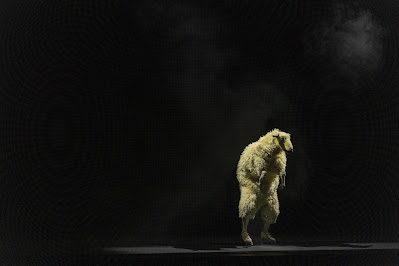The Sheep Song
Created by Jonas Vermeulen, Stef Aerts, Joé Agemans, Thomas Verstraeten, Marie
Vinck, Matteo Simoni with Stef Aerts, Bart Hollanders, Titus De Voogdt, Marie Vinck, Matteo Simoni,
Yorrith De Bakker. Production FC Bergman, Toneelhuis.
Lighting Design Ken Hioco. Sound Design Senjan Janssen. Costume Design Joëlle Meerbergen,
Music Frederik
Leroux-Roels. Coproduction: Holland Festival, Les Théâtres de
la Ville de Luxembourg, Piccolo Teatro di Milano - Teatro d'Europa. The Dunstan
Playhouse. Adelaide Festival Centre. Adelaide Festival. March 16-19 2023
Reviewed by Peter Wilkins
A naked man crosses the stage. He is covered
only by a red covering over his head and part way down his arms. He crosses to
a rope and pulls. The large bell above the stage tolls the commencement of the
surreal and fanciful The Sheep Song
by FC Bergman’s Toneelhuis from Belgium. There is a shuffling sound from behind
the curtain as the musician starts to play his mandolin. Lights come up on a
flock of sheep aimlessly circling, turning and occasionally gazing out at the
darkened auditorium. The music swells on the strings of the mandolin as one
sheep emerges, standing tall above the flock on hind legs, the rebel determined
to break free from the flock.
And so begins this evocative
fable about one member of the flock and his journey through the world of humans
in a quest for transformation and belonging. Each episode of his experience is chronicled
by the tolling of the bell and each event is punctuated by the rhythms of the
mandolin and the seductive soundscape. From the very outset of F C Bergman Toneelhuis’s
curiously unique production an audience is surprised, amazed by live sheep on
stage and then presented with an actor in sheep’s clothing, entering a world of
faceless humans, drawn into their parade along a moving platform as they lure
him into the transformative power of
imitation. What follows with such transfixing impact is a sequence of images luring the sheep more and more into the world
of human experience, while portraying the complex, brutal and disturbing world
of the human, a world that the sheep is eventually absorbed into.
F C Toneelhuis’s imagery is
startling and instantly expressive, leaving it to the audience to contemplate
and interpret. Th re is no text to sway opinion. There is no need. The image is
self-explanatory as a comment on the humanity that the sheep confronts and becomes
transformed by. Each graphically created image in the European tradition of such
artists as Tankred Dorst, Pina Bausch and the Flemish Primitives and offers a
cautionary view of a world, fraught with
peril. A blind woman is guided by a barking dog across the stage. The sheep is
mugged and beaten . A Punch and Judy puppet booth presents a ranting Hitler
puppet obsessed with his erect penis and assailed by a vengeful god. A matador
becomes the slain bull to suffer the inevitability of the bullfight. Doctors
deliver his half sheep half human perpetually wailing baby and he eventually
enters the world of faceless humanity.
On a deeper intellectual level, I ponder the
message of The Sheep Song. Is it a
rejection of difference? The satirical treatment
of the dictator would suggest not. Is it, like the words of Rita in West Side
Story, a warning to “stick to your own kind”? I would hope not. I would rather
believe that this thought-provoking work, visually mesmerizing and intellectually
exciting would be a plea for acceptance and tolerance. It is a decision that The Sheep Song leaves to its audience to
decide and perhaps in that decision to come to understand more about themselves
and who they really are. The Sheep Song
is a unique theatrical production that offers audiences a rare Adelaide
Festival experience.
Photos by Tom Standing


